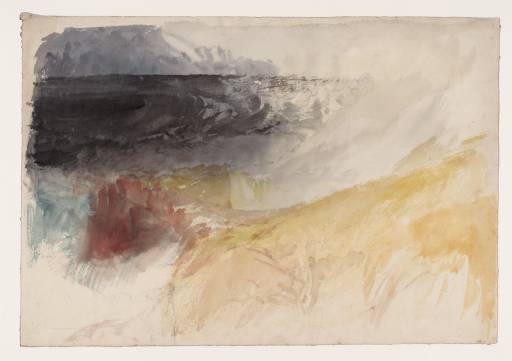Joseph Mallord William Turner Land's End, Cornwall c.1834
Joseph Mallord William Turner,
Land's End, Cornwall
c.1834
Joseph Mallord William Turner 1775–1851
Land’s End, Cornwall c.1834
D25129
Turner Bequest CCLXIII 7
Turner Bequest CCLXIII 7
Watercolour on white wove paper, 356 x 510 mm
Inscribed in red ink ‘7’ bottom right
Blind-stamped with Turner Bequest monogram towards bottom centre
Stamped in black ‘CCLXIII – 7’ bottom right
Inscribed in red ink ‘7’ bottom right
Blind-stamped with Turner Bequest monogram towards bottom centre
Stamped in black ‘CCLXIII – 7’ bottom right
Accepted by the nation as part of the Turner Bequest 1856
Exhibition history
1973
Landscape in Britain c.1750–1850, Tate Gallery, London, November 1973–February 1974 (214, reproduced, as ‘On the Coast’).
1997
Turner’s Watercolour Explorations 1810–1842, Tate Gallery, London, February–June 1997, Southampton City Art Gallery, June–September 1997 (67, reproduced in colour, as ‘Land’s End, Cornwall’, ?c.1834).
2006
Light into Colour: Turner in the South West, Tate St Ives, January–May 2006, Plymouth City Museum and Art Gallery, May–August 2006 (no number, reproduced, as ‘Land’s End’, c.1834).
2007
Hockney on Turner Watercolours, Tate Britain, London, June 2007–February 2008 (no number, reproduced, as ‘Land’s End, Cornwall’, ?c.1834).
References
1909
A.J. Finberg, A Complete Inventory of the Drawings of the Turner Bequest, London 1909, vol.II, p.815, CCLXIII 7, as ‘On the coast’. c.1820–30.
1997
David Hill, ‘Turner’s “Colour Beginnings” in Britain’, Turner Society News, no.76, August 1997, p.7.
1834
Eric Shanes, Turner’s Watercolour Explorations 1810–1842, exhibition catalogue, Tate Gallery, London, 1997, pp.16, 18, 78, 79, 94, 101, 104 (p.78–9 no.67, reproduced in colour, as ‘Land’s End, Cornwall’. ?c.1834, p.94 Appendix I under ‘Cornwall’, p.95 under ‘England and Wales Series’, as ‘Sketch, c.1834, for a view of Land’s End, Cornwall?’, p.98 under ‘Land’s End, Cornwall’, as ‘Sketch for a view of Land’s End’. c.1834, p.101 under ‘Sea Sketches and Studies’, p.104 Appendix II, as ‘Sketch: Land’s End, Cornwall?’).
2006
Sam Smiles, Light into Colour: Turner in the South West, exhibition catalogue, Tate St Ives 2006, reproduced in colour p.48, as ‘Land’s End’. c.1834.
2007
David Blayney Brown, Turner Watercolours, exhibition catalogue, Tate Britain, London 2007, p.86, reproduced in colour, as ‘Land’s End, Cornwall’. ?c.1834).
2007
Simon Grant (ed.) and David Blayney Brown, Hockney on Turner Watercolours, exhibition catalogue, Tate Britain, London 2007, p.43, reproduced in colour, as ‘Land’s End, Cornwall’. c.1834.
Turner visited Land’s End, the most westerly point of mainland England, on his West Country tour of 1811, when he made pencil drawings in the Cornwall and Devon sketchbook (Tate D08941, D08942, D41300–D41305, D41348, D41349; Turner Bequest CXXV 50, 51, CXXV a 24, 25, 26, 27, 28, 29, 66, 67). The first of these, D08941 (CXXV 50), a view to the north, was the basis of the untraced watercolour Land’s End, Cornwall: Approaching Thunderstorm of about 1813,1 engraved in 1814 for the Picturesque Views on the Southern Coast of England (Tate impressions: T04373, T04374, T05426–T05433, T05963).
The present work is one of eight ‘colour beginnings’ catalogued here as Land’s End subjects; the others are Tate D25163, D25165, D25172, D25274, D36323, D36324 and D36326 (Turner Bequest CCLXIII 41, 43, 50, 152, CCCLXV 32, 33, 35). A further colour study has been proposed as a Land’s End view among other possibilities (Tate D25185; Turner Bequest CCLXIII 63).
Eric Shanes suggests that the present study, D25172 and D36324 (CCLXIII 50, CCCLXV 33) are reworkings of the Southern Coast view, potentially for Turner’s later Picturesque Views in England and Wales. (The three compositionally and technically similar works can be dated after 1829 from the watermark of that year on the other half of the sheet of which the present work was originally part – see the technical notes below.) This approach was seemingly abandoned in favour of a fresh design, the watercolour Longships Lighthouse, Land’s End of about 1834 (J. Paul Getty Museum, Los Angeles),2 which was engraved in 1836 for England and Wales (no impressions held at Tate);3 D25163, D25165, D25274 and D36326 (CCLXIII 41, 43, 152, CCCLXV 35) may all relate to the latter composition.
David Hill has described the status of Shanes’s identification as ‘not proven or positively dubious’.4
See also the introductions to the present subsection of identified subjects and the overall England and Wales ‘colour beginnings’ grouping to which this work has been assigned.
Technical notes:
Acknowledging Peter Bower’s observation, Eric Shanes notes this work was originally half of a larger sheet; the other half, also used for a ‘colour beginning’ (Tate D36327; Turner Bequest CCCLXV 36), is watermarked ‘J Whatman | Turkey Mill | 1829’.1 Elsewhere, Bower describes D36327 as watercolour paper made by William Balston at the Springfield Mill, Maidstone, Kent, the original sheet being of Imperial format (averaging 22 x 30 inches, or 558 x 762 mm).2
Acknowledging Peter Bower’s observation, Eric Shanes notes this work was originally half of a larger sheet; the other half, also used for a ‘colour beginning’ (Tate D36327; Turner Bequest CCCLXV 36), is watermarked ‘J Whatman | Turkey Mill | 1829’.1 Elsewhere, Bower describes D36327 as watercolour paper made by William Balston at the Springfield Mill, Maidstone, Kent, the original sheet being of Imperial format (averaging 22 x 30 inches, or 558 x 762 mm).2
A vertical tear running some 75 mm from the left-hand end of the lower edge has been repaired.
Verso:
Blank; inscribed in pencil ‘D25129’ bottom right.
Blank; inscribed in pencil ‘D25129’ bottom right.
Matthew Imms
March 2013
How to cite
Matthew Imms, ‘Land’s End, Cornwall c.1834 by Joseph Mallord William Turner’, catalogue entry, March 2013, in David Blayney Brown (ed.), J.M.W. Turner: Sketchbooks, Drawings and Watercolours, Tate Research Publication, December 2013, https://www

